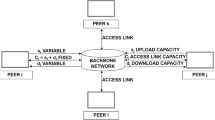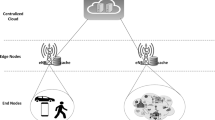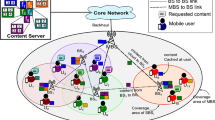Abstract
The Multimedia based application services have been getting attention in recent years in various fields. These services require a stringent delay resistant protocol in order to provide the best Quality of Service to end users. Existing protocols are predominantly designed using load balancing, tree, multi-tree and mesh based mechanisms. These mechanisms suffer in the presence of channel noise and incur more delay due to improper multicasting techniques adopted. Overlay network using hybrid (tree over mesh) structure along with multicasting strategies are used to address this issue. In this paper, an Improved Delay Resistant Adaptive Multicasting (IDRAM) model which adopts hybrid overlay creation, sub-packet based multi path transmission technique and error correction based on Forward Error Correction along with arbitrary IDRAM-A and selective IDRAM-S multicasting techniques are proposed and evaluated. Simulation is conducted to calculate frame success ratio, throughput, number of packet retransmission and transmission delay. The results obtained prove that IDRAM-S outperforms better than IDRAM-A and existing sub packet based multi path techniques. The number of retransmission requests made by IDRAM-S is reduced compared to the existing model. This reduction in the number of retransmission enables in minimizing end to end delay and thereby achieve stringent delay constraints associated with multimedia data delivery.












Similar content being viewed by others
References
Cisco Visual Networking Index Forecast. (2010–2015). http://www.cisco.com/en/US/solutions/collateral/ns341/ns525/ns537/ns705/ns827/white_paper_c11-481360.pdf. 2011.
Firdhous, M. (2011). Multicasting over overlay networks a critical review. International Journal of Advanced Computer Science and Application, 2(3), 54–61.
Sze, K. T., Ho, K. M., & Lo, K. T. (2013). Efficient video streaming over wireless mesh networks. In G. C. Yang, S. I. Ao, X. Huang & O. Castillo (Eds.), IAENG transactions on engineering technologies. Lecture notes in electrical engineering (Vol. 186, pp. 353–366). Dordrecht: Springer.
Barekatain, B., Khezrimotlagh, D., Maarof, M. A., et al. (2017). GAZELLE: An enhanced random network coding based framework for efficient P2P live video streaming over hybrid WMNs. Wireless Personal Communication, 95, 2485–2505. https://doi.org/10.1007/s11277-016-3930-4.
Han, S., Joo, H., Lee, D., & Song, H. (2011). An end-to-end virtual path construction system for stable live video streaming over heterogeneous wireless networks. IEEE Journal on Selected Areas in Communications, 29(5), 1032–1041.
Wu, J., Yuen, C., Cheng, B., Shang, Y., & Chen, J. (2015). Goodput-aware load distribution for real-time traffic over multipath networks. IEEE Transactions on Parallel and Distributed Systems, 26(8), 2286–2299.
Zhang, W., Lei, W., Liu, S., Guan, Y., & Li, G. (2004). Multipath transport based on application-level relay service and traffic optimization, information and communications technologies (ICT 2014). In 2014 international conference on, Nanjing, China, (pp. 1–8).
Kondo, T., Yokoyama, A., & Maeda, K. (2014). An implementation and evaluation of a selective QoS-aware mobile multicasting on multiple wireless networks. In Proceedings of seventh international conference on mobile computing and ubiquitous networking (ICMU) (pp. 188–193).
Wu, J., Wu, X., & Chen, J. (2014). SPMLD: Sub-packet based multipath load distribution for real-time multimedia traffic. Journal of Communications and Networks, 16(5), 548–558.
Prabhavat, S., Nishiyama, H., Ansari, N., & Kato, N. (2011). Effective delay-controlled load distribution over multipath networks. IEEE Transactions on Parallel and Distributed Systems, 22(10), 1730–1741.
Kandula, S., Katabi, D., Sinha, S., & Berger, A. (2007). Dynamic load balancing without packet reordering. ACM SIGCOMM Computer Communication Review, 37(2), 51–62.
Hui, C. C., & Chanson, S. T. (1999). Hydrodynamic load balancing. IEEE Transactions on Parallel and Distributed Systems, 10(11), 1118–1137.
Shi, W., MacGregor, M. H., & Gburzynski, P. (2005). Load balancing for parallel forwarding. IEEE/ACM Transactions on Networking, 13(4), 790–801.
Uma Maheswari, B., & Sudarshan, T. S. B. (2016). Error resilient multipath video delivery on wireless overlay networks. Telecommunication, Computing, Electronics and Control (TELKOMNIKA), 14(3), 894–903.
Wang, F., Xiong, Y., & Liu, J. (2010). mTreebone: A collaborative tree-mesh overlay network for multicast video streaming. IEEE Transactions on Parallel and Distributed Systems, 21(3), 379–392.
Fodor, V., & Chatzidrossos, I. (2008). Playback delay in mesh-based peer-to-peer systems with random packet forwarding. In Proceedings of second international conference on next generation mobile applications, services and technologies (pp. 550–555).
Chu, Y., Ao, S., Seshan, S., & Zhang, H. (2002). A case for end system multicast. IEEE Journal on Selected Areas in Communications, 20(8), 1456–1471.
Banerjee, S., Bhattacharjee, B., & Kommareddy, C. (2002). Scalable application layer multicast. In Proceedings of ACM SIGCOMM conference on applications, technologies, architectures, and protocols for computer communication (pp. 205–217).
Tran, D. A., Hua, K. A., & Do, T. (2003). ZIGZAG: An efficient peer-to peer scheme for media streaming. In Proceedings of 22nd annual joint conference of the IEEE computer and communications societies (IEEE INFOCOM) (pp. 1283–1292).
Zhang, B., & Chan, S. H. G. (2016). Overlay construction for mobile peer-to-peer video broadcasting—Approaches and comparisons. Peer-to-Peer Network Application, 9(6), 1060–1073.
Liu, Y., Guo, Y., & Liang, C. (2008). A survey on peer-to-peer video streaming systems. Peer-to-Peer Network Application, 1(1), 18–28.
Ghoshal, J., Xu, L., Ramamurthy, B., & Wang, M. (2007). Network architectures for live peer-to-peer media streaming. Technical report, Department of Computer Science and Engineering, University of Nebraska-Lincoln.
Liu, J., Rao, S. G., Li, B., & Zhang, H. (2008). Opportunities and challenges of peer-to-peer internet video broadcast. Proceedings of IEEE, 96(1), 11–24.
Magharei, N., & Rejaie, R. (2009). PRIME: Peer-to-peer receiver-driven mesh-based streaming. IEEE/ACM Transactions on Networking, 17(4), 1052–1065.
Zhang, X., Liu, J., Li, B., & Yum, T. P. (2005). CoolStreaming/DONet: A data-driven overlay network for peer to peer live media streaming. In Proceedings of 24th annual joint conference of computer and communications societies (pp. 2102–2111).
Ghoshal, J., Xu, L., Ramamurthy, B., & Wang, M. (2007). Network architectures for live peer-to-peer media streaming. Technical report, Department of Computer Science and Engineering, University of Nebraska-Lincoln.
Awiphan, S., Su, Z., & Katto, J. (2010). ToMo: A two-layer mesh/tree structure for live streaming in P2P overlay network. In Proceedings of 7th IEEE international conference on consumer communications and networking (pp. 1–5).
Asaduzzaman, S., Qiao, Y., & Bochmann, G. V. (2008). CliqueStream: An efficient and fault-resilient live streaming network on a clustered peer-to-peer overlay. In Proceedings of 8th IEEE international conference on peer-to-peer computing (pp. 269–278).
Uma Maheswari, B., & Sudarshan, T. S. B. (2016). Reputation based mesh-tree-mesh cluster hybrid architecture for P2P live streaming. In Proceedings of IEEE international conference on devices, circuits and systems (ICDCS 2016) (pp. 3–5).
ITU-T Recommendation. (2003). G.114: One-way transmission time. http://www.itu.int/rec/T-REC-G.114/en.
Guo, X., Liu, J., & Lian, S. (2011). Real-time video streaming over multipath in multi-hop wireless networks. Multimedia Systems, 17(4), 287–297. https://doi.org/10.1007/s00530-010-0210-0.
Tampere University of Technology, Ultra video group. http://ultravideo.cs.tut.fi/#testsequence.
Author information
Authors and Affiliations
Corresponding author
Additional information
Publisher's Note
Springer Nature remains neutral with regard to jurisdictional claims in published maps and institutional affiliations.
Rights and permissions
About this article
Cite this article
Balasubramanian, U.M., Shetty, T.K.R. An Improved Delay Resistant Adaptive Multicasting Strategy for High Definition Video Delivery in Wireless Overlay Network. Wireless Pers Commun 109, 61–75 (2019). https://doi.org/10.1007/s11277-019-06550-4
Published:
Issue Date:
DOI: https://doi.org/10.1007/s11277-019-06550-4




